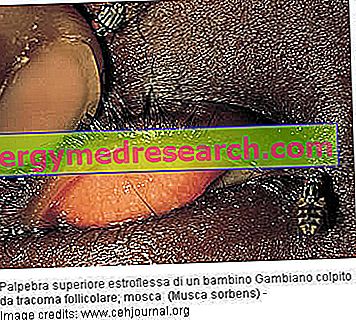What is the Tracoma?
Trachoma is an infectious disease of the conjunctiva and cornea caused by a bacterium: Chlamydia trachomatis . This pathological condition has numerous clinical manifestations resulting from active or previous infection.

Trachoma is an endemic spreading disease, but it especially affects the populations of developing countries (such as North Africa and India); it is transmitted mainly through contact with tear secretions and infected hands, contaminated clothing and insects. The infectious agent can also be transmitted through fecal contamination (it is endemic where hygiene rules are scarce). The clinical syndrome of trachoma can be effectively limited by the spread of antibiotic therapy.
Causes
Trachoma infection is caused by transmission of Chlamydia trachomatis (genus Chlamidia), a gram-negative bacterium, which can also cause infection by sexual transmission (see the article on chlamydia). The environmental risk factors are water shortages, flies, poor hygiene conditions and overcrowding in homes. The populations marked by poverty are at greater risk for the spread of the disease.
Trachoma spreads through interpersonal contact with secretions from the eyes, nose or throat of an infected person. The transmission of the infection can also take place by direct contact with contaminated objects (such as clothes, towels, etc.). In developing countries, flies and gnats act as a vector for the transmission of the infectious agent (they feed on eye secretions).
Chlamydia trachomatis for short
- Physiology / structure: obligate intracellular parasites in permissive cells (epithelial cells of the eye). The cell wall is similar to the Gram-, detectable with Giemsa coloration. They possess both DNA and RNA and prokaryotic ribosomes.
- Chlamydia trachomatis is sensitive to antibiotics.
- The site of the primary infection is local (it is not secondary to genital infection): it is mainly the conjunctiva and there is no systemic involvement.
Prolonged exposure to infection during infancy and early adulthood is necessary in order for secondary complications related to trachoma to arise: a single episode of acute conjunctivitis caused by Chlamydia trachomatis is not considered a threat to vision.
Pathogenesis
Following the infection by Chlamydia trachomatis, a set of leukocytes, polymorphonuclear cells and macrophages compact to form follicles below the conjunctival surface. The presence of scars in the conjunctiva can cause a rotation of the cilia ( entropion ), which are facing the cornea, causing abrasion ( trichiasis ). Subsequently, the constitution of the corneal cloth (vascularization, followed by infiltration) may cause partial or complete blindness. Alterations in tear flow are also common in this bacterial infection.
Risk factors
The factors that increase the risk of contracting trachoma are:
- Poverty . Iltracoma is a disease prevalent mainly in the extremely poor populations of developing countries. The communities of people who live in close contact (overcrowding conditions) are more susceptible to the transmission of infection.
- Poor hygiene . Poor sanitary conditions and lack of hygiene, such as unclean hands and face, contribute to spreading the disease. Moreover, populations that do not have access to sanitary facilities have a higher incidence of the disease.
- Age In areas where the disease is active, it is more common in children. The most affected age range is four to six years.
- Sex . Women contract the disease with higher rates than men.
Complications
An episode of Chlamydia trachomatis infection can easily be treated with an early diagnosis and the use of antibiotics. However, repeated infections can lead to complications, including:
- scarring of the inner eyelid
- eyelid deformity
- folding inward of the eyelid (entropion)
- ingrown eyelashes
- corneal scars
- partial or total blindness
Treatments and Cures
The options for treating trachoma depend on the stage of the disease. In the case of sporadic acute infections (early stages of the pathology) systemic treatment with broad-spectrum antibiotics is sufficient to eliminate the infection. Early intervention is useful, as the relapse rate is higher in more advanced stages of the disease.
Antibiotic therapy
Treatment with antibiotics involves topical application of an ophthalmic ointment based on doxycycline (1% tetracycline, twice a day for six weeks) or systemic administration of oral azithromycin (Zithromax).
Although azithromycin appears to be preferable and more effective than tetracycline (a single oral dose is sufficient), it is also the most expensive therapy. In poor communities, the choice of the drug to be used often depends on which one is available (generally azithromycin is included in the internationally organized donation program). As an alternative to the previously described antibiotics of choice, erythromycin or sulfonamides can also be administered.
The guidelines of the World Health Organization (WHO) recommend distributing antibiotics for an entire community when more than 10% of the children present in it have been affected by trachoma in order to treat those exposed to the infectious agent and reduce the spread of the disease.
Surgery
Surgical therapy is reserved for more advanced stages of the disease. Treatment of the advanced stages of trachoma, including deformity and pain in the eyelids may require surgery, performed on an outpatient basis. The procedure limits the progression of corneal scarring and can help prevent further vision loss. This procedure often greatly reduces the possibility of recurrence of the disease. If the cornea is seriously compromised, corneal transplantation is an option that offers some hope. Often, however, the results are not good.
Surgical treatment of trichiasis should be considered under one of the following conditions:
- presence of eyelashes turned inwards that cause the abrasion of the cornea;
- evidence of corneal damage from pre-existing trichiasis;
- severe vision reduction due to advanced disease progression.
Temporary and alternative options to surgery are epilation, to remove the eyelashes, or the? Affixing of a plaster over the lashes to prevent them from touching the eye.
Prognosis
Early treatment of the disease before the onset of scarring and eyelid deformity presents an excellent prognosis. In cases of trachoma not adequately treated with oral antibiotics, the symptoms can degenerate and cause blindness.



